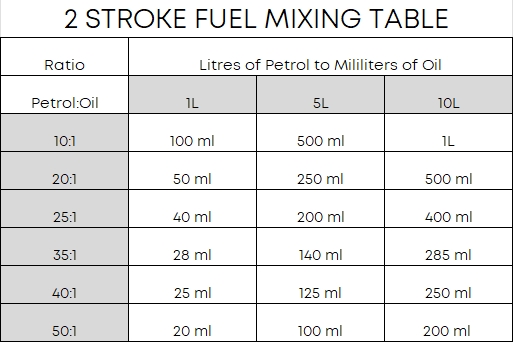Taking care of your 2-stroke engine: The art of mixing two-stroke fuel.

Taking care of your 2-stroke engine: The art of mixing two-stroke fuel.
When you buy a new power tool or machine, we advise that you
always check the accompanying manual to ensure what kind of engine or motor it
has and what kind of fuel it uses.
Your next step is to check if the engine has fuel and oil inside as using your equipment for the first time, without the necessary lubrication and correct fuel can lead to severe engine damage and your local retailer will not cover the damage if it results due to negligence.
What kind of fuel does a 2-stroke engine use:
2 Stroke engines don’t have a separate oil reservoir like
larger 4-stroke engines and thus you need to pre-mix your unleaded fuel and
2-stroke oil as per the manufacturer specification listed in your machine’s
manual. The oil in 2-stroke fuel is extremely important in lubricating your
engine.
What are the advantages of a 2-stroke engine?
2-stroke engines have a simpler design than other engines
which can make them easier to manufacture. They have a higher power-to-weight
ratio making them lighter and more compact. 2- Stroke engines also have a
higher power output compared to 4-stroke engines and the simpler design requires
less maintenance in terms of components to service or replace.
The disadvantages of these engines include higher levels of
exhaust emissions, less fuel-efficiency and more noise and vibration.
Why you shouldn’t put unlubricated fuel into a 2-stroke engine.
By forcing an engine to run without the correct lubrication,
the pistons and cylinders in the motor will get damaged and possibly seize.
This will lead to an engine rebuild which can be very expensive, so mixing the
correct fuel-to-oil ratio will not only lead to better efficiency of the
machine but will also lead to a longer life span of the engine.
What is the best 2-stroke ratio?
This depends entirely on your manufacturer’s instructions in
the manual as each engine can have unique requirements. If you don’t have a
manual and are unsure, a 40: 1 ratio is
a middle-range 2-stroke fuel (25 ml of two-stroke oil to 1 litre of petrol).
These ratios depend on the year the equipment was made and or the make of the
machine.
If you put too much oil, it may stop the engine, generate carbon build-up, blow smoke and too little engine oil will lead to overheating and damage your engine permanently.
How to mix your 2-stroke fuel
Step 1: Check your manufacturer manual to see what the required fuel-to-oil ratio is for your machine. Below is an easy-to-use table to ensure you mix the right quantities.
Step 2: Ensure you have all the tools and materials you will
need to mix the fuel properly.
- Petrol: Use fresh, unleaded petrol with the
recommended octane rating. Ensure your fuel never comprises more than 10 %
ethanol as ethanol attracts moisture when exposed to air. This can lead to
engine damage and leaking head gaskets.
- 2-Stroke
Oil: Choose a high-quality 2-stroke oil, designed for small engines.
Synthetic 2-stroke oil can ensure a smokeless burn and decrease fuel
consumption and although you can use mineral oils, they will eventually lead to
build-up inside the engine.
-
Fuel Container: Use a clean container for mixing
fuel as dirt and impurities can harm your engine.
-
Measuring cup: A measuring cup or container with
clear markings can help ensure accurate ratios, resulting in an increased
lifespan of your engine.
- Safety Gear: Always wear safety goggles and gloves when handling fuel and oil.
Step 3: Measure out your 2-stroke oil in the measuring cup.
Step 4: Add the ratio’s required amount of unleaded fuel to
your mixing container and follow by slowly adding the 2-stroke oil you measured
out in your measuring cup.
Step 5: Secure the fuel container’s lid and shake the
mixture vigorously for a minute or two to ensure a thorough mix.
Pro Tip: Use your 2-stroke fuel mixture within 30 days to
ensure the fuel is stable and combustible.
The key to maintaining the peak performance and longevity of your leaf blower or brush cutter lies in the proper fuel mixture. Always consult your equipment’s manual for specific recommendations. A little attention to detail during the fuel-mixing process will go a long way in ensuring your outdoor power tools serve you well for years to come. So, mix with care and let your equipment tackle yard work with ease.


